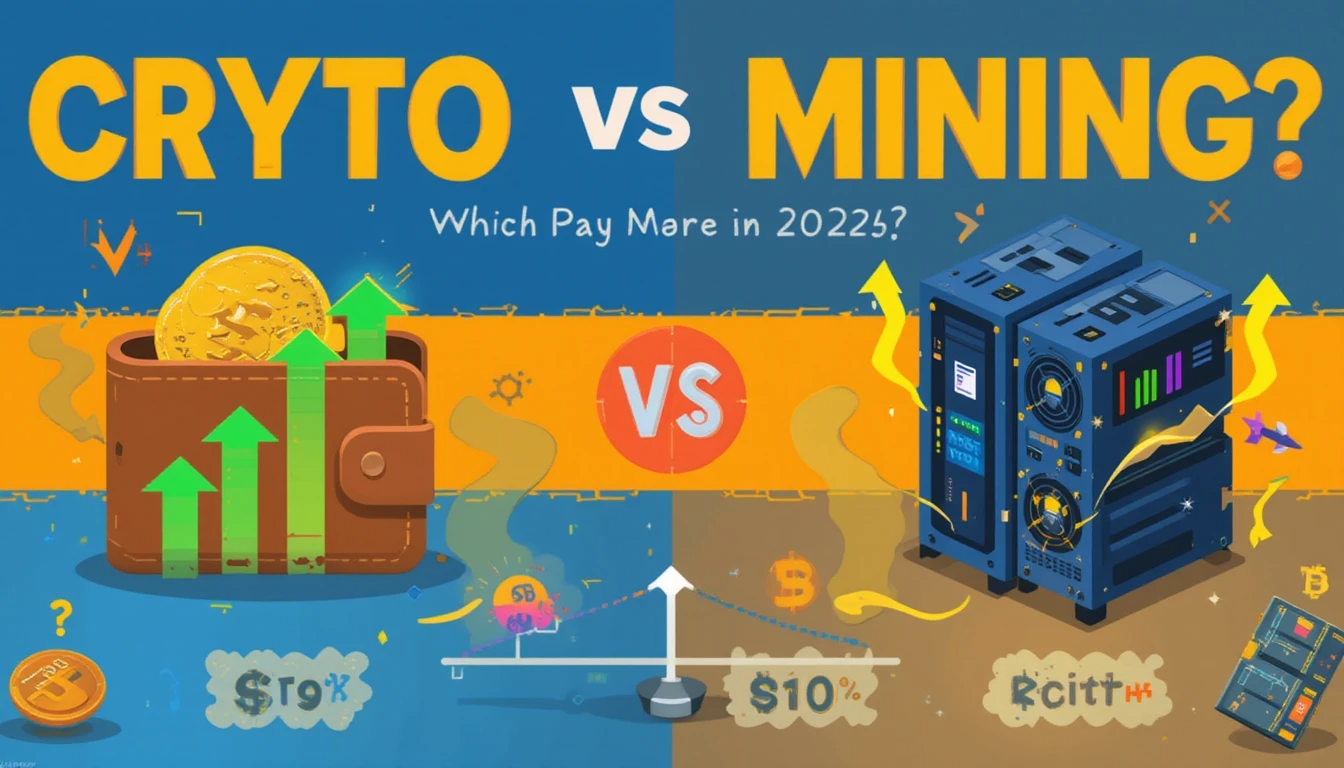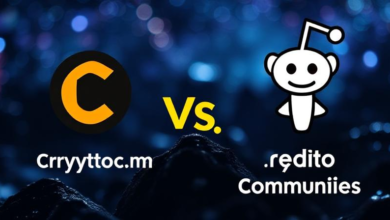
As cryptocurrency continues to evolve, investors are constantly debating Crypto Staking vs Mining to determine which method offers the best returns. Both staking and mining are popular ways to earn rewards in the crypto space, but their profitability depends on various factors—especially as we head into 2025. This crypto earnings comparison will dive deep into staking vs mining, exploring their mechanics, costs, risks, and potential staking profits to help you decide the best crypto method for maximizing earnings in the coming year. Whether you’re a beginner or a seasoned investor, this guide will equip you with the insights needed to choose wisely.
Understanding Crypto Staking vs Mining: The Basics
Before we compare profitability, let’s clarify what Crypto Staking vs Mining entails. Each method serves a critical role in blockchain networks but operates differently, impacting their earning potential.
What Is Crypto Staking?
Staking involves locking up your cryptocurrency in a Proof of Stake (PoS) blockchain to support network operations, like validating transactions. In return, you earn rewards—typically a percentage of your staked amount. Coins like Ethereum (ETH), Cardano (ADA), and Solana (SOL) are staking favorites, offering staking profits without the need for heavy hardware.
What Is Crypto Mining?
Mining, tied to Proof of Work (PoW) blockchains like Bitcoin (BTC), requires solving complex mathematical puzzles using powerful computers to validate transactions and add blocks to the chain. Miners are rewarded with newly minted coins and transaction fees, but the process demands significant energy and equipment investment.
This fundamental difference in staking vs mining sets the stage for our crypto earnings comparison in 2025.
Crypto Staking vs Mining: How They Work in 2025
To determine which pays more, let’s break down how Crypto Staking vs Mining operates in the current landscape.
How Staking Works
-
- Process: You lock coins in a wallet or platform (e.g., Binance, Coinbase) to become a validator or delegate to a staking pool.
-
- Rewards: Paid periodically (daily, weekly, monthly) based on your stake size and network rules—often 4–15% APY.
-
- Trends in 2025: Increased adoption of PoS chains and liquid staking (e.g., Lido) boosts accessibility and flexibility.
How Mining Works
-
- Process: Miners use specialized hardware (e.g., ASICs) to compete for block rewards, requiring constant operation and maintenance.
-
- Rewards: Vary by coin—Bitcoin offers 3.125 BTC per block (post-2024 halving), but competition is fierce.
-
- Trends in 2025: Rising energy costs and regulatory scrutiny challenge profitability, though advancements in hardware efficiency help.
Understanding these mechanics is key to identifying the best crypto method for staking profits or mining gains.
Crypto Earnings Comparison: Costs and Investments
Profitability hinges on upfront and ongoing costs. Here’s a crypto earnings comparison of Crypto Staking vs Mining in 2025.
Staking Costs
-
- Initial Investment: You only need to buy the cryptocurrency—e.g., $1,000 in ETH or ADA. No hardware required.
-
- Ongoing Costs: Minimal—some platforms charge small fees (e.g., 5–10% of rewards), but electricity and maintenance are negligible.
-
- Entry Barrier: Low, making it ideal for beginners or small investors seeking staking profits.
Mining Costs
-
- Initial Investment: High—ASIC miners cost $1,000–$10,000+, plus setup (cooling, space).
-
- Ongoing Costs: Electricity is the biggest expense, often $100–$500/month depending on local rates, plus hardware upkeep.
-
- Entry Barrier: High, favoring those with technical expertise and access to cheap power.
In staking vs mining, staking’s low cost makes it more accessible, while mining’s heavy investment can yield bigger rewards—if costs are managed.
Staking Profits vs Mining Rewards: 2025 Projections
Which method pays more in 2025? Let’s compare potential earnings in this Crypto Staking vs Mining analysis.
Staking Profits in 2025
-
- Reward Rates:
-
- Ethereum: 4–7% APY (~$120–$210/year on $3,000 staked at $3,000/ETH).
-
- Cardano: 4–5% APY (~$60–$75/year on $1,500 staked at $0.50/ADA).
-
- Solana: 6–8% APY (~$180–$240/year on $3,000 staked at $100/SOL).
-
- Reward Rates:
-
- Factors: Stable returns, but coin price volatility can affect total value. Liquid staking boosts flexibility.
-
- Profit Potential: Predictable, low-risk staking profits—ideal for passive income seekers.
Mining Rewards in 2025
-
- Reward Rates:
-
- Bitcoin: 3.125 BTC/block (~$187,500 at $60,000/BTC), shared among pool miners. Solo mining is rare due to competition.
-
- Smaller PoW coins (e.g., Litecoin): $50–$200/month with mid-tier rigs, depending on difficulty.
-
- Reward Rates:
-
- Factors: High rewards offset by electricity costs ($0.10/kWh = ~$150/month for a single ASIC) and hardware depreciation.
-
- Profit Potential: High upside for those with cheap energy, but breakeven can take months or years.
In this crypto earnings comparison, staking offers consistent returns with less risk, while mining’s profitability shines for those who can scale efficiently.
Crypto Staking vs Mining: Risks to Consider
Earnings aren’t just about rewards—risks play a huge role in determining the best crypto method. Here’s how Crypto Staking vs Mining stacks up.
Staking Risks
-
- Market Volatility: A coin’s price drop can erase staking profits (e.g., SOL falling from $100 to $50 halves your stake’s value).
-
- Lock-Up Periods: Funds may be inaccessible for days or months, limiting flexibility.
-
- Slashing: Rare, but validator errors can cut your stake (mitigated by choosing reputable pools).
Mining Risks
-
- Energy Costs: Rising electricity prices in 2025 could shrink margins, especially in high-cost regions.
-
- Hardware Failure: Rigs wear out or become obsolete, requiring reinvestment.
-
- Network Difficulty: Increased competition reduces individual rewards over time.
In staking vs mining, staking’s risks are tied to market swings, while mining’s hinge on operational costs—both demand careful planning to Stake Crypto Safely or mine profitably.
Best Crypto Method: Staking or Mining in 2025?
So, which is the best crypto method for you? Let’s weigh Crypto Staking vs Mining based on key factors.
When Staking Wins
-
- Low Budget: Start with as little as $100—perfect for staking profits without breaking the bank.
-
- Time Commitment: Set-and-forget nature suits busy individuals.
-
- Eco-Friendly: Minimal energy use aligns with 2025’s green trends.
-
- Example: Staking $1,000 in Solana at 7% APY nets $70/year with no upkeep.
When Mining Wins
-
- High Capital: $10,000+ investments in rigs can yield $500–$1,000/month if energy is cheap.
-
- Technical Skills: Suits those who can optimize hardware and power usage.
-
- Scalability: Large operations can outpace staking rewards.
-
- Example: Mining BTC with a $5,000 ASIC in a $0.05/kWh region could net $300/month after costs.
In this crypto earnings comparison, staking is the best crypto method for most, but mining shines for those with resources and expertise.
Staking Tips 2025: Maximizing Profits
To boost staking profits in Crypto Staking vs Mining, try these strategies:
-
- Diversify: Stake across ETH, ADA, and SOL to spread risk.
-
- Compound: Reinvest rewards to grow your stake exponentially.
-
- Choose Flexible Staking: Avoid long lock-ups for liquidity (e.g., Cardano).
Mining Tips 2025: Boosting Returns
For mining to outpace staking in staking vs mining:
-
- Cheap Energy: Relocate to low-cost regions or use solar power.
-
- Join Pools: Share rewards and reduce variance.
-
- Upgrade Gear: Invest in efficient ASICs to stay competitive.
Conclusion: Staking vs Mining—Which Pays More in 2025?
In the battle of Crypto Staking vs Mining, there’s no one-size-fits-all answer. Staking offers predictable, low-risk staking profits with minimal investment—making it the best crypto method for most in 2025. Mining, while potentially more lucrative, requires significant capital and operational savvy to overcome costs and risks. Your choice in this crypto earnings comparison depends on your budget, goals, and risk tolerance.
Ready to earn? Start staking with a small amount on Binance or explore mining if you’ve got the setup. The crypto world rewards action—pick your path and profit in 2025!




